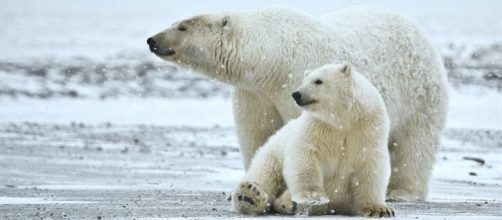Research carried out by the U.S. Geological Survey has revealed that a section of Arctic Polar Bears are losing weight during the time when they should be putting on weight. This is the observation of wildlife biologist Anthony Pagano who is the lead author of this study. Researchers conducted the study over a period of 10 days in April. This is when the females begin to put on weight to take on the responsibility of giving birth and tending to the cubs during the harsh winter months.
Daily Mail UK reports that the shrinking of ice in the Arctic due to climate change is a threat for them since they feed on seal pups and have to go hungry when they cannot catch their prey.
The United States Fish and Wildlife Service have included the polar bears in the category of endangered species.
Climate change is to blame
Scientists have put the blame squarely on global warming which is responsible for the dwindling ice cover on the Arctic Ocean. The polar bears need the ice shelves for hunting seals each spring, and the absence of this platform means the animals have to travel long distances in search of their prey.
In order to carry out the research, the scientists attached tracking collars with video cameras on nine giant female polar bears. Their weight and blood pressure were recorded, and the study showed that they lost weight daily and the loss was significant. The average polar bear weighed about 386 pounds, and one of them lost 51 pounds in a short span of nine days.
These animals prey on the seals that stay in holes. When they pop out for air, the bears go after them. In case the ice is broken, the bears are forced to swim longer distances and use up more energy. Some of them have traveled more than 155 miles in about 10 days’ time off the northern coast of Alaska.
The study involved tracking only the females because the males have small heads and long necks and are not able to keep the collars.
The future is gloomy
Blaine Griffen, a biology professor who was not a part of the study, has lauded the study. In his opinion, it was unlike previous studies that were undertaken in the labs. If the trend is not checked, climate change could lead to smaller polar bears that will give birth to fewer cubs with low survival rates.
Incidentally, the ice cover in the Arctic grows during winter and melts in the summer, and global warming has led to the shrinking and thinning of the ice. This is undesirable and is posing survival problems for them. In fact, scientists have evidence of weak polar bears in the region.


